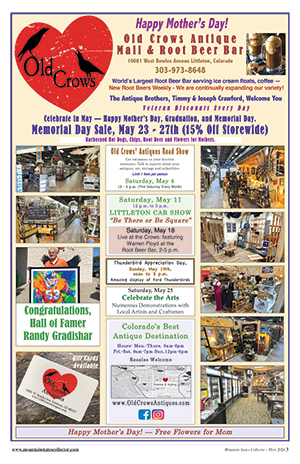 By Robert Reed
By Robert Reed Ever since baseball began there has been bit-by-bit collecting of it, and as the great American pastime has grown so have the bits and the numbers of collectors.
Fans seek out everything from key chains to bleacher seats, from buttons to Wheaties cereal boxes, from ticket stubs to Jim Bouton’s book, Ball Four.
In 1988, for the first time in history, the glitzy New York City auction house Christie’s conducted a gallery sale devoted entirely to sports memorabilia. Among other things, a 1969 New York Mets championship ring brought over $8,000.
For the first hundred years or so of baseball’s existence collecting memorabilia was a relatively modest affair. In 1979 a national magazine noted that former St. Louis Browns player Roy Sievers had been offered $5,000 for his 1950s uniform. He declined, saying he still sometimes wore it to old-timers games.
In 1990, Mickey Mantle’s playing jacket from the 1950s sold for several thousand dollars. A letter of authenticity with it noted that Mick had worn it during spring training with the New York Yankees in 1954. It was eventually given to his high school coach and later sold as part of his estate.
Things directly from the game, like uniforms, caps, and jackets are especially treasured in the field. “Hundreds of thousands of different baseball collectibles have been issued during the past century,” says Dr. James Beckett author of The Sport Americana Price Guide to Baseball Collectibles. “Such increasing interest in such memorabilia is naturally reflected in the values of these items. As more collectors compete for available supplies, prices rise.”
 Balls, bats, gloves, spikes, and even uniform patches qualify. In recent years Guernsey’s sporting auction in New York has sold George Selkirk’s ca. 1936 New York Yankees cap for $1,500, and a 1988 Keith Hernandez Mets home jersey, with a letter of authenticity, for $500.
Balls, bats, gloves, spikes, and even uniform patches qualify. In recent years Guernsey’s sporting auction in New York has sold George Selkirk’s ca. 1936 New York Yankees cap for $1,500, and a 1988 Keith Hernandez Mets home jersey, with a letter of authenticity, for $500. Leland’s, another leading sports memorabilia mail auction, sold a wood-slatted stadium seat from Commiskey Park (Chicago). The seat dated to 1910 and was removed in the late 1940s and sent to the minor league Waterloo Diamonds. The seat sold with a letter from an official of the Waterloo baseball club.
It is always a good idea to have proof regarding ‘from the game’ baseball memorabilia. In Collector’s Guide to Baseball Memorabilia author Don Raycraft relates a deal he made as a youngster in the early 1950s. He traded 385 Topps baseball cards from the 1953 season for a ball fouled off by Jim Rivera.
“When he came home from work that night,” admits Raycraft, “my father pointed out to me that American League teams did not normally buy their baseballs at Montgomery Ward.”
Much baseball memorabilia is simply down on paper. The Christie’s auction of 1988 saw a handwritten letter by famed shortstop Honus Wagner. Today, instead of his playing, he is much more famous for one of his baseball cards which brought $500,000.
Wagner’s letter to one of his fans described a difficult play:
“Batter hits a low line hit to my right. I dove for the ball and caught it with my bare hand about three inches from the ground. My jump took me head first into the ground and I came up with the ball and made a double play.”
The letter brought over $1,000. At a similar auction a Hall of Fame postcard signed by Cy Young with his image on it brought $750.
These Hall of Fame postcards with photographs of an individual player’s plaque with yellow background have been available since 1964. They were issued by the National Baseball Hall of Fame in Cooperstown, New York. Earlier cards by Albertype and Artvue Company were issued in black and white.
Also on paper are stock certificates, one from the 1940s St. Louis Browns went for $350; signed checks, one from Walter Johnson on a Germantown bank in Maryland dated 1942 brought $800 at a Leland sale; programs, tickets, magazines with baseball-related covers and guide books issued as premiums by liquor companies.
During much of the 20th century a great deal of memorabilia connected to the game was sold right over the counter.
An attractive box from the 1930s that once packaged Babe Ruth’s All-American Athletic Underwear complete with the great star’s image on front would bring several hundred dollars today. Then there is a Joe Dimaggio advertising wall calendar from the 1950s, or the great Gillette Razor Company merchandise and premiums from the 1930s through the 1960s – including World Series specialty items.
During the 1950s and early 1960s the Hartland Plastic Company of Hartland, Wisconsin, issued 18 different statues of major league baseball stars. From 1958 to 1963 they sold at dime stores for $2 to $3 each. Now they are quite collectible.
Different baseball fans usually collect different things. But the field’s most accomplished collector has a bit of everything these days. Barry Halper, a New Jersey businessman, at one time had 900 player uniforms, 3,000 autographed baseballs, every all-star game program, world series programs going back nearly 80 years, and even the autograph of the person many say invented the game itself at Cooperstown in 1839, Abner Doubleday.
Most collectors of such things have far less of it but enjoy what they have tremendously.
“In collecting baseball memorabilia,” notes Stew Salowitz in his collector’s guide co-authored with Raycraft, “people are surrounding themselves with history – with at bats, hits, runs, errors, diving catches, chewing tobacco, bubble gum and the illustrious characters who played the game for our enjoyment.”

















Follow Us